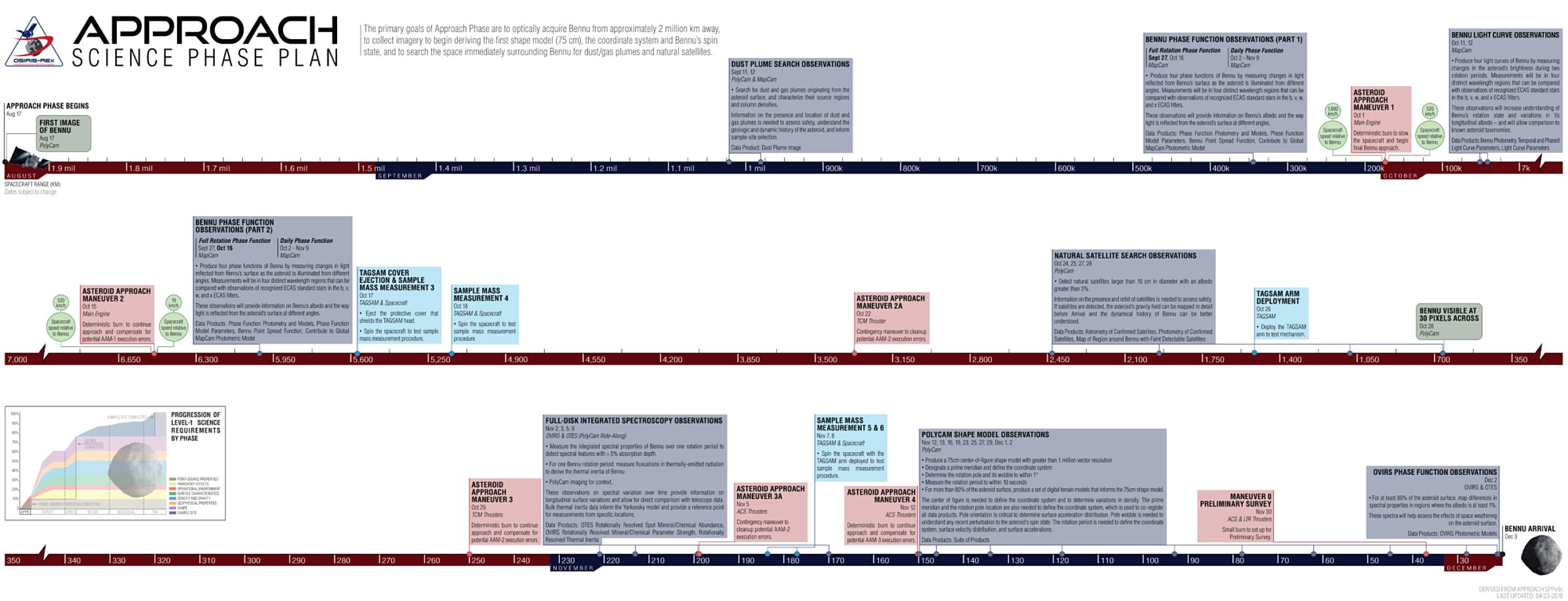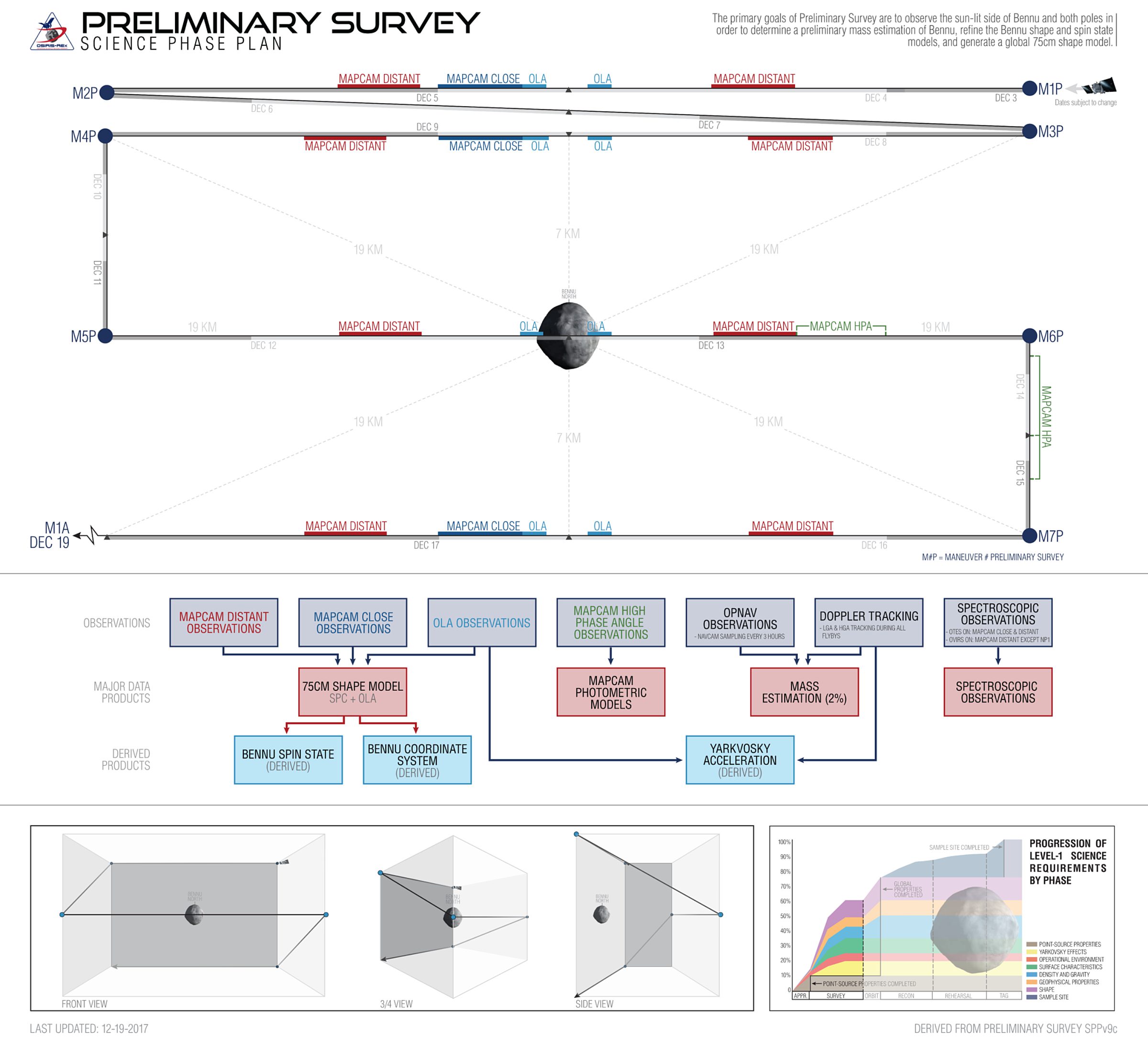Emily Lakdawalla • Jun 12, 2018
Get ready for OSIRIS-REx at Bennu! ...but be patient.
As Hayabusa2 coasts toward Ryugu, a second asteroid sample return mission is nearing its own rendezvous. NASA's OSIRIS-REx will get the first sight of its target Bennu in August and go into orbit in December. It's a bit early to post about what to expect, but Hayabusa2's impending arrival is making a lot of people (including me) ask "Are we there yet? Are we there yet?" about OSIRIS-REx.
The short answer to that question: No, we're not there yet, and it's going to be quite a while until we see cool high-resolution pictures of Bennu. But your patience will be rewarded. The mission team has described their plans in excruciating detail in a Lauretta et al. paper in Space Science Reviews. Thhis paper is exceptionally well-organized and readable with excellent figures and is open-access, so if this blog post doesn't give you enough detail, go check the paper out.
This mission requires real-time science in a way that's much more like a rover mission than like an orbital mission. To rove Mars safely, rovers need to have 3D data on the terrain immediately surrounding them; they have to generate new terrain maps after every drive. To orbit Bennu safely and accurately, OSIRIS-REx has to develop Bennu terrain and gravity maps in real time. The science, engineering, and navigation are all intertwined.
The mission is divided into distinct phases. We're currently in Outbound Cruise. The Approach phase starts on August 17 with the first planned pictures of Bennu, and concludes in December. The Approach phase is extremely important for both science and spacecraft health. It's also going to be a maddeningly long period of Bennu being a tiny, flickering point or vaguely lumpy dot. Be patient for the next many months, folks. Enjoy Hayabusa2's sportier approach to its asteroid while you wait for OSIRIS-REx to get going. (Actually, the public won't be the only ones watching Hayabusa2 dance around Ryugu while we wait for OSIRIS-REx to get closer to Bennu; the two mission teams are cooperating very closely and will share what they learn with each other to help each other in the challenging work of navigating close to such a gravitationally tiny world.)

Okay, let's step through each of the planned mission phases.
Launch was at 23:05 UT on 8 September 2016.
Outbound cruise: included a deep space maneuver on 28 December 2016, an Earth gravity assist on 22 September 2017, and a search for Earth Trojan asteroids (none was discovered).
Approach: 17 August to 30 November 2018. OSIRIS-REx will do optical navigation, search for satellites and potential dust hazards, and characterize Bennu as a point source for comparison with Earth-based data. It'll do photometry, measuring the rotation rate, measure thermal inertia, get spectral slopes, and pay very close attention to the asteroid's reflectance in the infrared wavelength in which the laser ranging instrument operates. At the very end of the approach phase, they'll start working on an asteroid shape model. Below is a much more detailed timeline for the Approach phase.

Preliminary survey: December 2018. OSIRIS-REx will perform three passes across the asteroid, one each across the poles and equator, approaching to within 7 kilometers. This is close enough for a precise determination of the asteroid's mass, and also to complete the data set needed to make a detailed shape model of the asteroid. These two data sets together will let the team develop a coordinate system and the base maps on which all the rest of the mission's data will be plotted. Here's a detailed look at the preliminary survey plans. This is the last such infographic that the OSIRIS-REx team has produced for public view; I'm sure we'll eventually get graphics for later parts of the mission.

Orbital A: End December 2018-mid February 2019. OSIRIS-REx's first orbit will have a 1.0- to 1.5-kilometer radius (measured from Bennu's center) and will be in the same plane as the terminator (so, over the poles along the line separating day from night). The alignment with the terminator is to make it so there will be no net effect of solar radiation pressure on the spacecraft's orbit. During Orbital Phase A, the team will work on switching over from using stars as their navigational reference to using surface features as their navigational reference, which will be more precise.
Detailed survey: Baseball diamond: February-April 2019. Moving to a slightly greater distance (3.5 kilometers), OSIRIS-REx will take numerous photos of the asteroid from four locations (akin to the four bases surrounding the pitcher's mound in baseball, hence the "baseball diamond"). At the end of the detailed survey, they'll have a new, more detailed shape model; a global image mosaic with a pixel scale of 4 centimeters; and a "thematic map" showing regions of scientific interest and regions that might be hazardous to the spacecraft. Sequences of images taken during this period "will be released as public engagement products that will provide a sense of spacecraft flight over the asteroid."
Detailed survey: Equatorial stations: April-June 2019. More distance again (5 kilometers from the asteroid's center), to seven different positions over Bennu's equator. These data will help the team build models for how the surface of Bennu reflects light differently at different angles. This is called photometry. With this data set, the team will be able to correct images for solar illumination, to help them produce seamless photo mosaics. Once they have the photometry data set in hand, they'll be able to make color ratio maps, which should make subtle color variations on the asteroid much easier to see. They'll also make a map of the asteroid's thermal properties. In the long term, these maps will be important for geology research, but in the short term, it will help identify regions of interest and regions that are hazardous for sampling. The team is even prepared to produce a map of plumes coming from Bennu, though they call the discovery of plumes "low probability." At the end of the detailed survey phase, the team should have a list of as many as 12 candidate sample sites.
Orbital B: June-September 2019. Similar to Orbital phase A, OSIRIS-REx will be in a close, 1.0- to 1.5-kilometer orbit. The main goal of this phase will be mapping with the laser altimeter and radio tracking for mass and gravity studies. It will also survey the candidate landing sites. During this phase, the science team will develop data that will be returned to the spacecraft to support its autonomous guidance system, getting ready for the landing and sample grab. By the end of orbital phase B, the team will have downselected to two potential sample sites, one primary and one secondary.
Reconnaissance: September-December 2019. OSIRIS-REx will perform very close passes across the potential sample sites, as low as 225 meters above the surface. They will be able to see individual particles as small as 2 centimeters across.
Rehearsal: December 2019-June 2020. At least two rehearsals will put OSIRIS-REx partway through the steps of descending to the asteroid's surface to collect a sample, but neither is planned to actually contact the surface.
Sample Collection: July 2020. This will get a whole blog entry when the time is right.
Sample stowage: Once the mission is sure the spacecraft got a sample, they'll go through the process of moving the sample head into the sample return capsule and then severing the arm to allow the capsule to close.
Departure: March 2021.
Earth return: September 24, 2023, at 14:40 UTC. The long delay between departure and return is very convenient for the science team, who will make good use of that time writing papers.


 Explore Worlds
Explore Worlds Find Life
Find Life Defend Earth
Defend Earth

